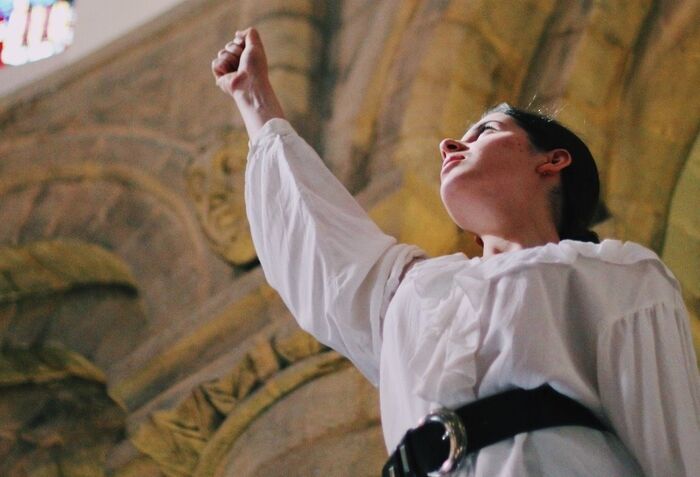Saint Joan review
A compelling and humanizing, but overly long and dense exploration of the mythical life of Joan of Arc

Joan of Arc is a larger-than-life figure, a martyr and a saint whose story has taken on the qualities of myth. George Bernard Shaw dramatized what little we actually know about her life in this play, entitled simply Saint Joan. He humanizes her, while still showing us how she became the figure we know about today. She is not just a tragically flawed hero; she is a young girl, petulant and proud, with personality and fervour that echo through the centuries.
It seems appropriate to begin by talking about Joan herself: portrayed by Louisa Stuart-Smith, this naïve, pious, stubborn, conceited yet charming and infectiously optimistic character becomes entirely believable. Stuart-Smith’s stiff and upright body language, lively and dramatic movements, and passionate speech all serve to engage the audience with her struggle. Somehow she is both annoying and endearing, frustratingly arrogant yet unbelievably courageous – as Poulengey (Rowan Gow) says, “there is something about her”.
"For a period piece about faith, war, and political intrigue, Saint Joan is a surprisingly funny play"
Joan’s saintly nature is emphasized throughout the play by the lighting. At one point she is bathed in the kind of golden light that comes through stained-glass windows. For that and for the flickering orange light that gives the impression of a huge fire, Lighting Designer Emily Brailsford deserves special praise. The costumes and the set-design are also excellent in setting the right medieval tone, as is the music used between scenes.

At the same time, the play feels very modern in the way the characters express themselves, and this grounds the narrative, making it easier for the audience to understand the people they are watching. Besides Joan, Dominic Carrington’s Charles is the most developed in terms of personality, and Carrington handles his transition from young Dauphin to older and wiser King deftly. The other actors all do impressive jobs, each embodying a variety of roles, with Warwick (Rosy Sida) and the Chaplain (Clara Morel) taking the crown for most delightfully dislikeable. For a period piece about faith, war, and political intrigue, Saint Joan is a surprisingly funny play; Morel displayed peak comedic timing across her roles, most notably in her opening scene as Steward to Squire Baudricourt (William Batty), and Jade Franks brought some much-needed levity and irreverence to her scenes as the Page and as the Soldier.
Unfortunately, the play’s humour is not quite enough to compensate for how long and dense it is. The sheer number of characters who navigate shifting conflicts and alliances with each other based on their complex and diverging beliefs and motivations makes for a lot of monologues and long-winded debates, on top of the exposition that is needed to fill gaps about battles, grand coronations, and Joan’s capture. Exploring each character’s philosophical motivations is undoubtedly fascinating, but not enough of an emotional connection was built for me to feel like I cared about any of the character arcs other than Joan’s. So unless lengthy politico-historical intrigue is a particular passion of yours, you may find that tedium has set in by the end of the two-and-a-half-hour run-time.
Saint Joan is a compelling, but protracted look at a woman who became a myth. This is the kind of play that I would strongly recommend to people with the appropriate interests but not recommend at all to others – hopefully I’ve given you a good enough idea of what to expect so you know which category you belong to!
 News / Pembroke to convert listed office building into accom9 December 2025
News / Pembroke to convert listed office building into accom9 December 2025 News / Uni Scout and Guide Club affirms trans inclusion 12 December 2025
News / Uni Scout and Guide Club affirms trans inclusion 12 December 2025 Features / Searching for community in queer Cambridge10 December 2025
Features / Searching for community in queer Cambridge10 December 2025 News / Uni redundancy consultation ‘falls short of legal duties’, unions say6 December 2025
News / Uni redundancy consultation ‘falls short of legal duties’, unions say6 December 2025 News / Gov declares £31m bus investment for Cambridge8 December 2025
News / Gov declares £31m bus investment for Cambridge8 December 2025









